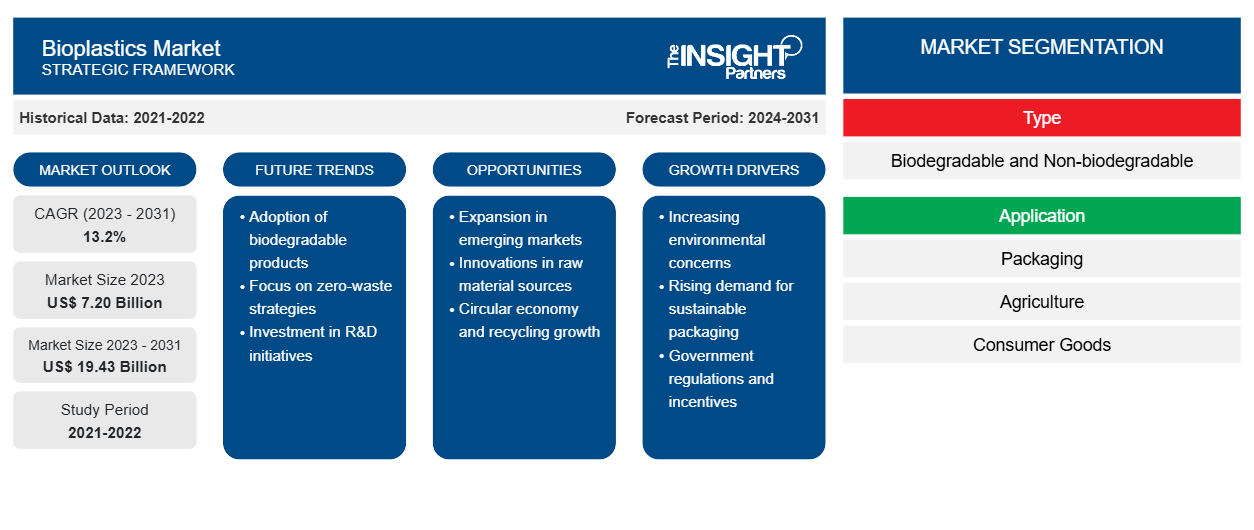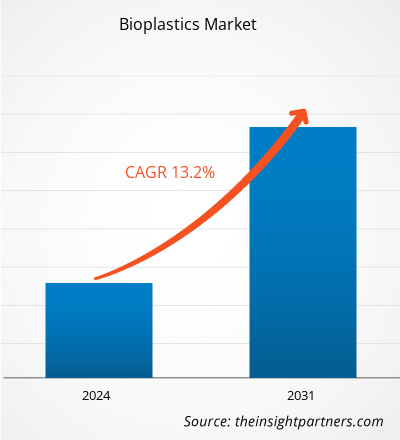Bioplastics Market Growth, Analysis, and Forecast by 2031
Historic Data: 2021-2022 | Base Year: 2023 | Forecast Period: 2024-2031Bioplastics Market Size and Forecast (2021–2031), Global and Regional Share, Trend, and Growth Opportunity Analysis Report Coverage: By Type (Biodegradable and Non-biodegradable), Application (Packaging, Agriculture, Consumer Goods, Automotive & Transportation, Textiles, Building & Construction, and Others), and Geography
- Report Date : Mar 2026
- Report Code : TIPRE00003267
- Category : Chemicals and Materials
- Status : Data Released
- Available Report Formats :


- No. of Pages : 150
The bioplastics market size is projected to reach US$ 19.43 billion by 2031 from US$ 7.20 billion in 2023. The market is expected to register a CAGR of 13.2% in 2023–2031. The increasing focus on innovation and technological advancement is likely to remain key bioplastics market trends.
Bioplastics Market Analysis
The growing environmental concerns and a global endeavor to lessen pollution is driving the demand for biodegradable plastics in the packaging sector across the globe. In addition, the demand for bioplastics in the packaging industry is expected to grow due to the rising need for different healthcare products. Further, it’s easy for manufacturers to manufacture bioplastic packaging because packaging produced from biopolymers can usually be produced employing standard plastics processing technology. The growing demand for eco-friendly plastics in the packaging sector is a major factor expected to boost the bioplastics market growth across the globe over the forecast period.
Bioplastics Market Overview
Bioplastics are plastic materials that are made up of renewable biomass sources, which include vegetable fats and oils, corn starch, straw, woodchips, sawdust, and recycled food wastes, among others. Bioplastics are being increasingly used to reduce the problem of plastic waste that is suffocating the planet and contaminating the environment; along with this, the production of bioplastic requires 65% less energy than conventional petroleum plastic.
Customize This Report To Suit Your Requirement
You will get customization on any report - free of charge - including parts of this report, or country-level analysis, Excel Data pack, as well as avail great offers and discounts for start-ups & universities
Bioplastics Market: Strategic Insights

-
Get Top Key Market Trends of this report.This FREE sample will include data analysis, ranging from market trends to estimates and forecasts.
Bioplastics Market Drivers and Opportunities
Rising Demand for Bioplastics in Various Application Fields
The rising demand for bioplastics in various application fields is an important driver for the bioplastics market. Bioplastics are used in numerous end-use industries such as medical, automotive, and transportation, packaging, agriculture, consumer goods, textiles, building and construction, and others. In the medical sector, bioplastics have comprehensive applications in wound management, tissue engineering, drug delivery, orthopedic devices, and manufacturing of fibrous and porous scaffolds. In the automotive sector, bioplastics offer reduced dependency on fossil resources, reduction in the cost of manufacturing, and significantly reduced carbon footprint. Further, bioplastics are utilized for cosmetics rigid packaging of compact powders, creams, lipsticks, and beverage bottles.
Stringent Government Laws and Regulations on Traditional Plastic Use
Numerous countries across the globe have implemented plastic-related laws and regulations. Various countries are making efforts to ban single-use plastic and promote sustainable alternatives to it. This will help in mitigating the ill effects on human life and the environment. Hence, the stringent government laws and regulations on traditional plastic use are expected to offer more lucrative opportunities for the bioplastics market growth.
Bioplastics Market Report Segmentation Analysis
Key segments that contributed to the derivation of the bioplastics market analysis are type and application.
- Based on type, the market is segmented into biodegradable and non-biodegradable. The biodegradable segment held a larger market share in 2023.
- By application, the market is segmented into packaging, agriculture, consumer goods, automotive & transportation, textiles, building & construction, and others. The packaging segment held the largest share of the market in 2023.
Bioplastics Market Share Analysis by Geography
The geographic scope of the bioplastics market report is mainly divided into five regions: North America, Asia Pacific, Europe, Middle East & Africa, and South & Central America.
The global market was dominated by Asia Pacific. Europe is a second major contributor to the global bioplastics market share. In North America, bioplastics are widely consumed in the packaging sector in the form of plastic bottles and bags. Production and consumption of bioplastics are expected to grow in the region, primarily in food packaging applications. Unlike traditional plastics, bioplastics are obtained from renewable sources. The automotive industry in this region is one of the most advanced industries globally due to substantial investments in infrastructure, R&D activities, and new production facilities. Bio-polyamides (Bio-PA), polylactic acid (PLA), and bio-based polypropylene (Bio-PP) are bioplastics that are highly used in automotive manufacturing. These factors are driving the automotive bioplastics market growth.
Bioplastics Market Regional Insights
The regional trends and factors influencing the Bioplastics Market throughout the forecast period have been thoroughly explained by the analysts at The Insight Partners. This section also discusses Bioplastics Market segments and geography across North America, Europe, Asia Pacific, Middle East and Africa, and South and Central America.
Bioplastics Market Report Scope
| Report Attribute | Details |
|---|---|
| Market size in 2023 | US$ 7.20 Billion |
| Market Size by 2031 | US$ 19.43 Billion |
| Global CAGR (2023 - 2031) | 13.2% |
| Historical Data | 2021-2022 |
| Forecast period | 2024-2031 |
| Segments Covered |
By Type
|
| Regions and Countries Covered |
North America
|
| Market leaders and key company profiles |
|
Bioplastics Market Players Density: Understanding Its Impact on Business Dynamics
The Bioplastics Market is growing rapidly, driven by increasing end-user demand due to factors such as evolving consumer preferences, technological advancements, and greater awareness of the product's benefits. As demand rises, businesses are expanding their offerings, innovating to meet consumer needs, and capitalizing on emerging trends, which further fuels market growth.

- Get the Bioplastics Market top key players overview
Bioplastics Market News and Recent Developments
The bioplastics market is evaluated by gathering qualitative and quantitative data post primary and secondary research, which includes important corporate publications, association data, and databases. The following is a list of developments in the market for speech and language disorders and strategies:
- SABIC, a global leader in the chemical industry, launched today a new portfolio of bio-based ULTEM™ resins that offer sustainability benefits while delivering exactly the same high performance and processability as incumbent ULTEM materials. These breakthrough polyetherimide (PEI) materials are the first certified renewable, high-performance, amorphous polymers available in the industry. (Source: SABIC, News and Media/Latest News/October 2021)
- Toray Industries, Inc., announced today that it has developed a nylon 510 (N510) fiber that incorporates 100% ‘biobased synthetic polymer content’ as defined under section 3.1.5 of ISO 16620-1: 2015, the international standard for the biobased content of plastics. Ecodear N510 will be the first 100% plant-based nylon fiber in Toray’s Ecodear lineup. (Source: TORAY INDUSTRIES, INC., Newsroom/ January 2022)
Bioplastics Market Report Coverage and Deliverables
The “Bioplastics Market Size and Forecast (2021–2031)” report provides a detailed analysis of the market covering below areas:
- Market size and forecast at global, regional, and country levels for all the key market segments covered under the scope
- Market dynamics such as drivers, restraints, and key opportunities
- Key future trends
- Detailed Porter’s Five Forces and SWOT analysis
- Global and regional market analysis covering key market trends, major players, regulations, and recent market developments
- Industry landscape and competition analysis covering market concentration, heat map analysis, prominent players, and recent developments
- Detailed company profiles
Habi is a seasoned Market Research Analyst with 8 years of experience specializing in the Chemicals and Materials sector, with additional expertise in the Food & Beverages and Consumer Goods industries. He is a Chemical Engineer from Vishwakarma Institute of Technology (VIT) and has developed deep domain knowledge across industrial and specialty chemicals, paints and coatings, paper and packaging, lubricants, and consumer products. Habi’s core competencies include market sizing and forecasting, competitive benchmarking, trend analysis, client engagement, report writing, and team coordination—making him adept at delivering actionable insights and supporting strategic decision-making.
- Historical Analysis (2 Years), Base Year, Forecast (7 Years) with CAGR
- PEST and SWOT Analysis
- Market Size Value / Volume - Global, Regional, Country
- Industry and Competitive Landscape
- Excel Dataset
Related Reports
Testimonials
The Insight Partners' SCADA System Market report is comprehensive, with valuable insights on current trends and future forecasts. The team was highly professional, responsive, and supportive throughout. We are very satisfied and highly recommend their services.
RAN KEDEM Partner, Reali Technologies LTDsI requested a report on a very specific software market and the team produced the report in a few days. The information was very relevant and well presented. I then requested some changes and additions to the report. The team was again very responsive and I got the final report in less than a week.
JEAN-HERVE JENN Chairman, Future AnalyticaWe worked with The Insight Partners for an important market study and forecast. They gave us clear insights into opportunities and risks, which helped shape our plans. Their research was easy to use and based on solid data. It helped us make smart, confident decisions. We highly recommend them.
PIYUSH NAGPAL Sr. Vice President, High Beam GlobalThe Insight Partners delivered insightful, well-structured market research with strong domain expertise. Their team was professional and responsive throughout. The user-friendly website made accessing industry reports seamless. We highly recommend them for reliable, high-quality research services
YUKIHIKO ADACHI CEO, Deep Blue, LLC.This is the first time I have purchased a market report from The Insight Partners.While I was unsure at first, I visited their web site and felt more comfortable to take the risk and purchase a market report.I am completely satisfied with the quality of the report and customer service. I had several questions and comments with the initial report, but after a couple of dialogs over email with their analyst I believe I have a report that I can use as input to our strategic planning process.Thank you so much for taking the extra time and making this a positive experience.I will definitely recommend your service to others and you will be my first call when we need further market data.
JOHN SUZUKI President and Chief Executive Officer, Board Director, BK TechnologiesI wish to appreciate your support and the professionalism you displayed in the course of attending to my request for information regarding to infectious disease IVD market in Nigeria. I appreciate your patience, your guidance, and the fact that you were willing to offer a discount, which eventually made it possible for us to close a deal. I look forward to engaging The Insight Partners in the future, all thanks to the impression you have created in me as a result of this first encounter.
DR CHIJIOKE ONYIA MANAGING DIRECTOR, PineCrest Healthcare Ltd.Reason to Buy
- Informed Decision-Making
- Understanding Market Dynamics
- Competitive Analysis
- Identifying Emerging Markets
- Customer Insights
- Market Forecasts
- Risk Mitigation
- Boosting Operational Efficiency
- Strategic Planning
- Investment Justification
- Tracking Industry Innovations
- Aligning with Regulatory Trends




















 Get Free Sample For
Get Free Sample For